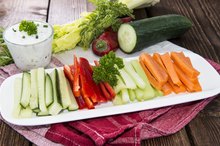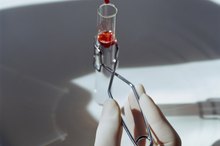What does fact checked mean?
At Healthfully, we strive to deliver objective content that is accurate and up-to-date. Our team periodically reviews articles in order to ensure content quality. The sources cited below consist of evidence from peer-reviewed journals, prominent medical organizations, academic associations, and government data.
- Office of Dietary Supplements: Dietary Supplement Fact Sheet -- Iron
- MedlinePlus; "Potassium in Diet"; Dr. David Zieve; May 2010
The information contained on this site is for informational purposes only, and should not be used as a substitute for the advice of a professional health care provider. Please check with the appropriate physician regarding health questions and concerns. Although we strive to deliver accurate and up-to-date information, no guarantee to that effect is made.
What Do Grapes Do to Your Body?
Fresh grapes are a delicious snack that can provide a healthy means of satisfying the occasional sweet tooth craving. Grapes are a source of several important nutrients that your body needs to function properly. Of course, eating grapes as a snack by themselves is only one way to enjoy them. For example, you can mix them into chicken salad for a uniquely sweet sandwich.
Vitamin C
One cup of raw seedless grapes contains 16.3 mg of vitamin C. According to the University of Maryland Medical Center, men should consume about 90 mg of vitamin C per day, and women should consume about 75 mg per day 3. Your body needs vitamin C to build the collagen found in your skin, ligaments and tendons, as well as to help fight damage that can be caused by free radicals.
Potassium
Red Cherries & Potassium
Learn More
Each one-cup serving of grapes contains 288 mg of potassium. The mineral potassium is an electrolyte, which helps conduct electrical signals in the body; it also helps develop and grow muscles and process protein and carbohydrates. Both men and women should consume about 4,700 mg of potassium per day; 5,100 mg for women who are breastfeeding.
Phosphorus
According to the University of Maryland Medical Center, phosphorus is the second most plentiful mineral in the body after calcium 3. Calcium and phosphorus are both major components of teeth and bones; phosphorus is also used to facilitate proper kidney function, as well as energy production and use. A cup of raw grapes contains 30 mg of phosphorus; adults need a total of about 700 mg of phosphorus per day.
- According to the University of Maryland Medical Center, phosphorus is the second most plentiful mineral in the body after calcium 3.
- Calcium and phosphorus are both major components of teeth and bones; phosphorus is also used to facilitate proper kidney function, as well as energy production and use.
Iron
Vitamins & Minerals in Potatoes
Learn More
A cup of raw grapes contains 0.54 mg of iron. Your body needs iron to create new red blood cells and to transport the oxygen you breathe throughout the body so that it can be used. Adult men need 8 mg of iron per day; adult women need 18 mg per day until age 50, after which they need 8 mg per day.
Related Articles
References
- Office of Dietary Supplements: Dietary Supplement Fact Sheet -- Iron
- MedlinePlus; "Potassium in Diet"; Dr. David Zieve; May 2010
- University of Maryland Medical Center; "Phosphorus"; Steven Ehrlich; June 2009
- Guerrero RF, García-Parrilla MC, Puertas B, Cantos-Villar E. Wine, resveratrol and health: A review. Nat Prod Commun. 2009;4(5):635-58.
- Grapes, American type, raw. FoodData Central. U.S. Department of Agriculture. Published April 1, 2019.
- Atkinson FS, Foster-Powell K, Brand-Miller JC. International tables of glycemic index and glycemic load values: 2008. Diabetes Care. 2008;31(12):2281-3. doi:10.2337/dc08-1239
- Tomé-Carneiro J, Larrosa M, Yáñez-Gascón MJ, et al. One-year supplementation with a grape extract containing resveratrol modulates inflammatory-related microRNAs and cytokines expression in peripheral blood mononuclear cells of type 2 diabetes and hypertensive patients with coronary artery disease. Pharmacol Res. 2013;72:69-82. doi:10.1016/j.phrs.2013.03.011
- Russo M, Spagnuolo C, Tedesco I, Bilotto S, Russo GL. The flavonoid quercetin in disease prevention and therapy: Facts and fancies. Biochem Pharmacol. 2012;83(1):6-15. doi:10.1016/j.bcp.2011.08.010
- Pasinetti GM, Wang J, Ho L, Zhao W, Dubner L. Roles of resveratrol and other grape-derived polyphenols in Alzheimer's disease prevention and treatment. Biochim Biophys Acta. 2015;1852(6):1202-8. doi:10.1016/j.bbadis.2014.10.006
- Szkudelski T, Szkudelska K. Resveratrol and diabetes: from animal to human studies. Biochim Biophys Acta. 2015;1852(6):1145-54. doi:10.1016/j.bbadis.2014.10.013
- American Academy of Allergy Asthma and Immunology. Anaphylactic actions to cherries, strawberries, and grapes. Updated April 12, 2018.
- Berkeley Wellness, University of California. Types of grapes. Updated July 10, 2015.
- Grape juice, 100%. FoodData Central. U.S. Department of Agriculture. Published April 1, 2019.
- Consumer Reports. Is the cloudy coating on blueberries safe to eat?. Updated May 17, 2010.
Writer Bio
Joseph McAllister has worked as a writer since 2003. He has more than seven years of experience in training and coaching martial arts. McAllister writes for various websites on a variety of topics including martial arts, competition and fitness. He graduated from Liberty University on a full ride National Merit Scholarship with a Bachelor of Science in print journalism.









